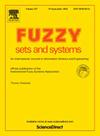On strict fuzzy betweenness relations
IF 2.7
1区 数学
Q2 COMPUTER SCIENCE, THEORY & METHODS
引用次数: 0
Abstract
Fuzzy betweenness relations have gained increasing attention since Zhang et al. recently established their extensive connections with fuzzy order relations. In this manuscript, we delve into the exploration of strict fuzzy betweenness relations from two aspects. First of all, in light of one of the most important examples of strict betweenness relations from strict order relations, we extend this paradigm to the fuzzy case. Specially, with respect to a t-norm ⁎ and a fuzzy equivalence relation E, we construct a strict ⁎-E-betweenness relation from a strict ⁎-E-order relation. Secondly, by establishing a one-to-one correspondence between strict betweenness relations and betweenness relations, we investigate whether this elegant result persists within the many-valued setting. Toward this end, we present the construction of a strict fuzzy betweenness relation from a fuzzy betweenness relation and vice versa, scrutinizing the conditions under which these constructions are inverse to each other. The conclusion turns out that the correspondence in the fuzzy context exhibits distinct differences from the crisp one, primarily due to the inherent complexity of fuzzy logic.
关于严格模糊间关系
自从Zhang等人最近建立了模糊间性关系与模糊序关系的广泛联系以来,模糊间性关系得到了越来越多的关注。本文从两个方面对严格模糊间关系进行了探讨。首先,根据严格序关系中严格间性关系的一个最重要的例子,我们将这一范式推广到模糊情况。特别地,对于一个t-范数和一个模糊等价关系E,我们从一个严格的 -E-序关系构造了一个严格的 -E-间关系。其次,通过建立严格间性关系和间性关系之间的一对一对应关系,我们研究了这个优雅的结果在多值设置中是否持续存在。为此,我们提出了从模糊间关系到严格模糊间关系的构造,反之亦然,仔细研究了这些构造彼此相反的条件。结论表明,模糊语境下的对应关系与清晰语境下的对应关系存在明显差异,这主要是由于模糊逻辑固有的复杂性。
本文章由计算机程序翻译,如有差异,请以英文原文为准。
求助全文
约1分钟内获得全文
求助全文
来源期刊

Fuzzy Sets and Systems
数学-计算机:理论方法
CiteScore
6.50
自引率
17.90%
发文量
321
审稿时长
6.1 months
期刊介绍:
Since its launching in 1978, the journal Fuzzy Sets and Systems has been devoted to the international advancement of the theory and application of fuzzy sets and systems. The theory of fuzzy sets now encompasses a well organized corpus of basic notions including (and not restricted to) aggregation operations, a generalized theory of relations, specific measures of information content, a calculus of fuzzy numbers. Fuzzy sets are also the cornerstone of a non-additive uncertainty theory, namely possibility theory, and of a versatile tool for both linguistic and numerical modeling: fuzzy rule-based systems. Numerous works now combine fuzzy concepts with other scientific disciplines as well as modern technologies.
In mathematics fuzzy sets have triggered new research topics in connection with category theory, topology, algebra, analysis. Fuzzy sets are also part of a recent trend in the study of generalized measures and integrals, and are combined with statistical methods. Furthermore, fuzzy sets have strong logical underpinnings in the tradition of many-valued logics.
 求助内容:
求助内容: 应助结果提醒方式:
应助结果提醒方式:


